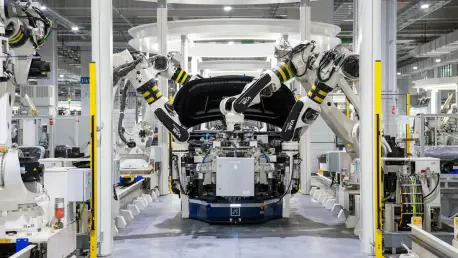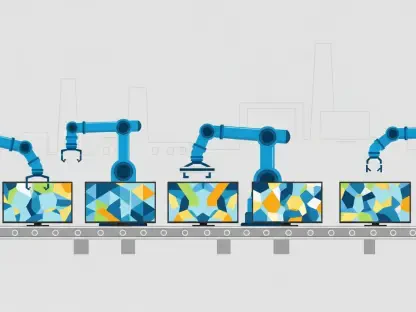In a landscape where industrial automation and digital transformation are reshaping entire sectors, Lantronix, Inc. (LTRX) stands out as a company navigating a critical juncture, as revealed in its Q4 2025 earnings call. Known for its contributions to the industrial Internet of Things (IoT) and Edge AI, Lantronix is undergoing a profound shift from a traditional hardware supplier to a provider of integrated, platform-based solutions. This transition, highlighted by strategic moves and financial recalibrations, offers a unique lens into the broader trends driving automation today. As industries increasingly demand real-time data processing and operational efficiency, the company’s latest results shed light on how it is positioning itself to meet these needs. This analysis delves into the earnings call to uncover the key drivers behind Lantronix’s trajectory, exploring what its pivot means for the future of industrial automation and how it reflects the evolving demands of a technology-driven market.
Redefining Identity Through Strategic Focus
Lantronix is decisively moving away from its legacy as a hardware-centric vendor, channeling efforts into high-margin, high-growth areas such as Edge AI, unmanned aerial systems (UAS), and IoT infrastructure modernization. A pivotal aspect of this transformation is the deliberate reduction of reliance on fluctuating contracts, exemplified by the decision to scale back on the Gridspertise deal, which once accounted for a significant portion of revenue. By focusing on core strengths, the company achieved a commendable 4% year-over-year revenue growth in fiscal 2025, excluding that contract. This shift underscores a strategic preference for sustainable income over short-term boosts, aligning with an industry-wide push toward long-term value creation. The emphasis on scalable solutions positions Lantronix to capitalize on emerging demands for integrated systems that go beyond mere hardware, setting a foundation for deeper market penetration in automation.
This strategic realignment also reflects a keen awareness of where future opportunities lie within industrial automation. By prioritizing sectors like Edge AI and UAS, Lantronix is tapping into markets that promise substantial growth and require sophisticated, connected solutions. The move away from volatile revenue sources indicates a calculated effort to build a more predictable financial base, which is crucial in a sector prone to rapid technological shifts. Moreover, this focus on high-margin offerings suggests an ambition to not just participate but lead in niche areas of automation. As industries pivot toward smarter, data-driven operations, Lantronix’s direction appears to be in sync with the need for systems that deliver continuous value through software-like models, hinting at a broader transformation in how technology providers approach their business.
Strengthening Operations and Financial Health
Operational efficiency has become a cornerstone of Lantronix’s strategy, evidenced by a rigorous 90-day cost-reduction initiative that trimmed operating expenses by $4 million. Alongside this, the company has realigned its supply chain by relocating U.S.-bound manufacturing outside of China, a move that mitigates risks from tariffs and geopolitical uncertainties. These efforts have contributed to an improved gross margin outlook, with targets set to reach 44–45% by 2026. Financially, the refinancing of $11.8 million in term debt into an asset-backed line of credit, combined with a net cash position of $8.3 million as of June 30, 2025, demonstrates a commitment to liquidity and adaptability. Such measures provide a buffer against market volatility, allowing Lantronix to maintain focus on innovation while ensuring operational stability in a competitive environment.
Beyond cost-cutting and supply chain adjustments, the financial discipline exhibited by Lantronix points to a broader strategy of resilience. The enhanced liquidity not only safeguards against unforeseen disruptions but also offers flexibility for strategic investments, whether in research and development or potential acquisitions. This pragmatic approach to balancing cost management with growth opportunities is particularly relevant in industrial automation, where rapid advancements demand constant reinvestment. By fortifying its financial position, Lantronix is better equipped to navigate the challenges of scaling new technologies and partnerships. These operational and financial maneuvers collectively signal a mature strategy aimed at sustaining growth while addressing the inherent uncertainties of a fast-evolving sector.
Capturing Emerging Market Opportunities
Lantronix is aggressively positioning itself in nascent but promising markets, notably through its involvement in the U.S. Army’s Black Widow drone program and design wins with over 10 drone manufacturers. Projections suggest the drone segment could account for 10–15% of total revenue by 2027, highlighting its potential as a significant growth driver. Additionally, a multi-year contract with a major U.S. mobile carrier to modernize 50,000 backup power systems underscores the company’s shift toward recurring revenue models similar to software-as-a-service (SaaS). Partnerships with entities like Aurora and FLIR for integrating AI and thermal imaging into autonomous systems further cement Lantronix’s role in defense and telecom supply chains, aligning with the rising demand for advanced, connected technologies in industrial automation.
The focus on emerging markets like UAS and Edge AI illustrates Lantronix’s intent to embed itself in sectors where compliance, security, and real-time processing are paramount. These areas, particularly defense and telecommunications, are experiencing heightened investment as industries seek to leverage automation for efficiency and safety. The recurring revenue approach, seen in multi-year contracts and platform integrations, marks a departure from traditional one-off sales, offering a more stable financial outlook. This strategy not only enhances customer retention but also positions Lantronix to capture a larger share of the value chain. As these markets are projected to expand significantly over the coming years, the company’s early foothold could translate into substantial competitive advantages, provided execution remains consistent.
Aligning with Broader Industry Shifts
The Q4 2025 earnings call from Lantronix highlights a critical trend in industrial automation: the accelerating adoption of digital transformation across various sectors. Driven by the need for real-time decision-making, enhanced data privacy, and operational efficiency, companies are increasingly turning to Edge AI and IoT solutions. Lantronix’s pivot to platform-based offerings mirrors a sector-wide recognition that standalone hardware sales are insufficient for sustained growth. Instead, integrated, subscription-based models are gaining traction, particularly in defense, telecom, and industrial inspection—areas where Lantronix is actively carving out space. This alignment with industry demands suggests a forward-looking approach to meeting customer needs through continuous value delivery.
Another key industry shift reflected in Lantronix’s strategy is the emphasis on supply chain resilience in a post-pandemic world. By diversifying manufacturing and reducing exposure to geopolitical risks, the company is addressing a pressing concern for many in the automation sector. This focus on operational agility is essential for maintaining competitive margins and ensuring scalability amid economic uncertainties. The trend toward digital and automated solutions also underscores the growing importance of data security and low-latency processing, areas where Lantronix’s offerings are directly relevant. As industries continue to prioritize these elements, the company’s current direction appears well-suited to capitalize on the evolving landscape, provided it can sustain momentum and adapt to changing conditions.
Navigating Risks Amid Ambitious Growth
While Lantronix’s vision for growth in markets like drones and Edge AI is promising, with projections estimating a $250 billion market by 2030, significant execution risks remain. Challenges such as potential reductions in U.S. defense spending or difficulties in scaling new partnerships could hinder progress. These uncertainties are compounded by the competitive nature of industrial automation, where technological advancements and market dynamics shift rapidly. Despite these hurdles, Lantronix’s operational adjustments, including a leaner cost structure and supply chain diversification, demonstrate a practical mindset aimed at mitigating such risks. The balance between innovation and stability will be crucial as the company seeks to establish itself as a leader in high-growth niches.
Financial improvements, such as increased liquidity and debt restructuring, provide Lantronix with a cushion to invest in research or strategic moves, yet the path forward is not without volatility. Short-term fluctuations in market demand or regulatory changes could pose obstacles, particularly in defense-related segments. Success will largely depend on the ability to execute on ambitious plans while maintaining operational discipline. For stakeholders, the current valuation metrics, including a forward P/E ratio of 12x and P/S of 0.8x, suggest an attractive opportunity, but patience may be required to see the full impact of this pivot. As Lantronix navigates these challenges, its ability to adapt and innovate will determine whether it can turn potential into sustained growth within the industrial automation space.
Charting the Path Ahead in Automation
Reflecting on Lantronix’s Q4 2025 earnings call, it becomes evident that the company has laid critical groundwork for a transformative journey in industrial automation. The deliberate shift toward high-margin, platform-driven solutions, paired with operational efficiencies, positions it to address the growing appetite for digital and automated systems. For industry watchers and investors, the next steps involve closely monitoring how Lantronix executes on its ambitious plans in emerging markets like drones and Edge AI. Exploring strategic partnerships or acquisitions could further accelerate its trajectory, while continued focus on supply chain resilience might shield against global disruptions. As the sector evolves, staying attuned to market adoption rates and technological advancements will be essential to gauge the long-term impact of these efforts.









